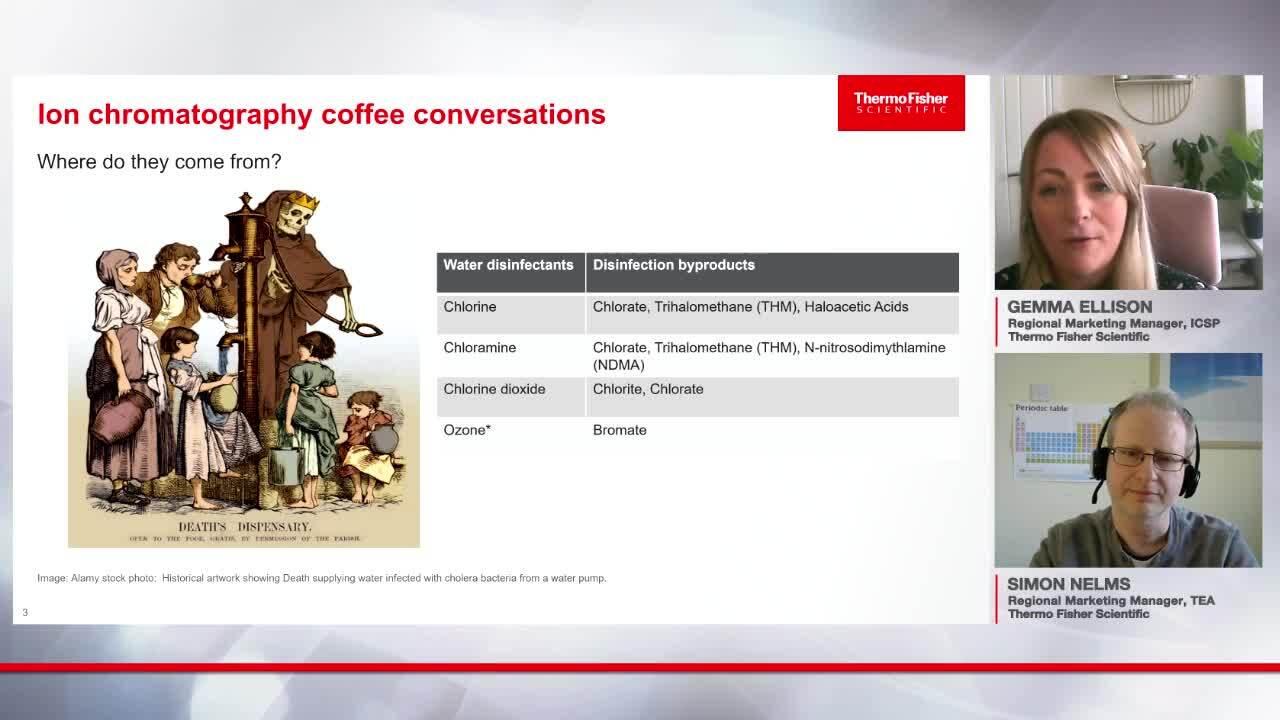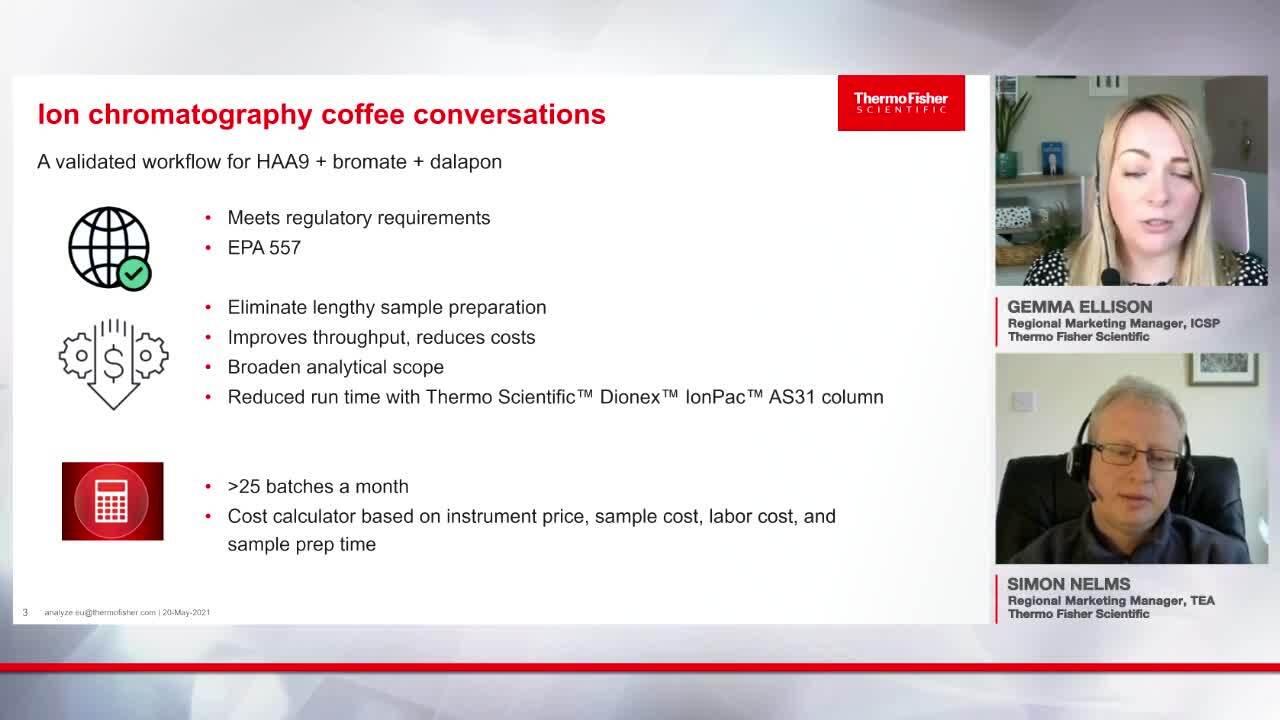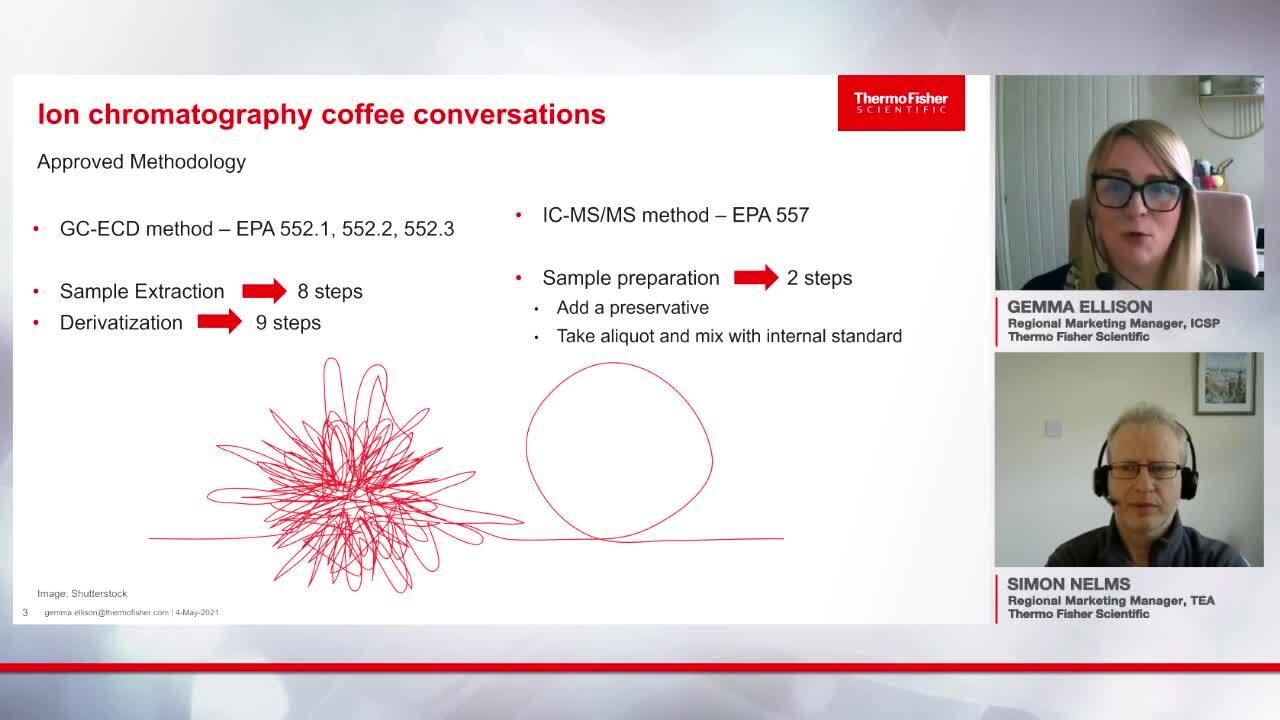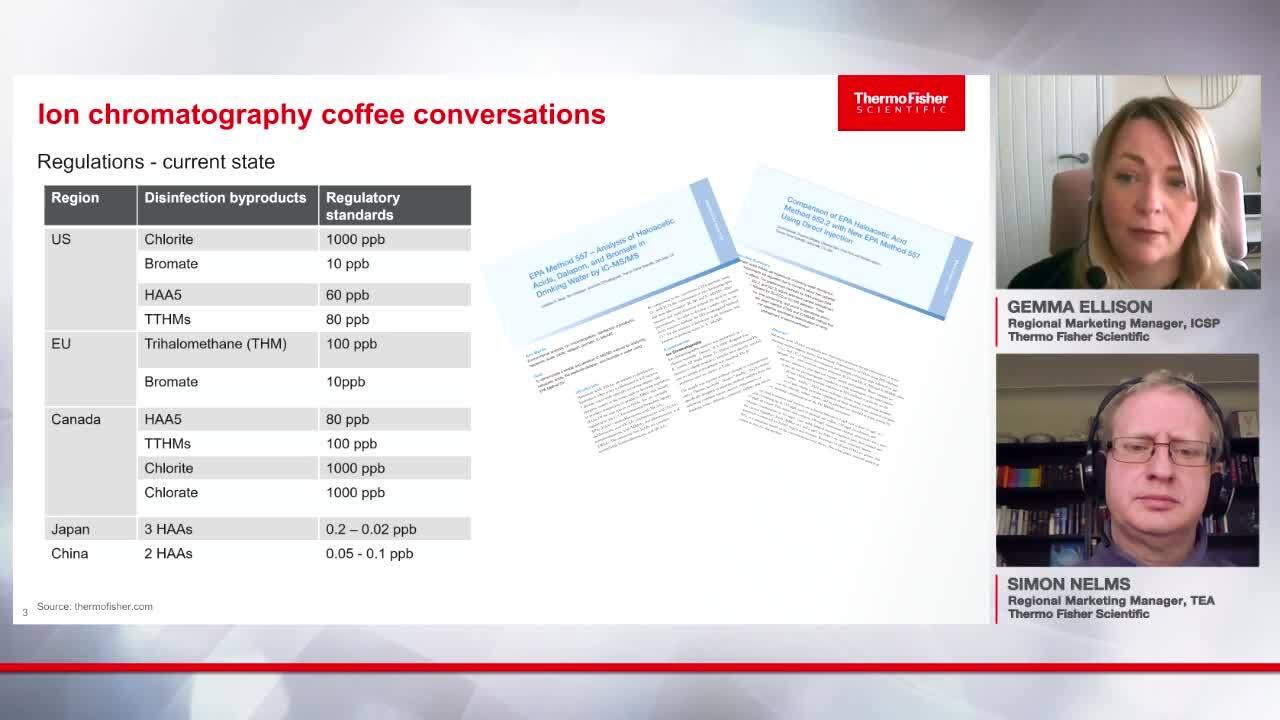
Drinking water disinfection by-products by IC-MS/MS
Disinfection is important in ensuring the supply of pathogen-free drinking water. However, excessive consumption of disinfection by-products (DBPs), such as haloacetic acids (HAAs), bromate, and dalapon can result in health issues. With increasing regulatory focus on DBPs, drinking water facilities around the world need hands-off, high-throughput analyses of these contaminants.
Accelerate your haloacetic acids, bromate, and dalapon analyses
The Thermo Scientific Disinfection By-Products (DBPs) Application Workflow includes an integrated Thermo Scientific ion chromatography-tandem mass spectrometry (IC-MS/MS) system with direct injection to eliminate sample preparation. It provides rapid, cost-effective drinking water testing per United States Environmental Protection Agency (U.S. EPA) Method 557.
Compared to using gas chromatography-electron capture detection (GC-ECD) per U.S. EPA Method 552.3, this workflow eliminates time-consuming, complicated manual sample preparation steps. Unlike other IC-MS/MS solutions, Thermo Fisher Scientific manufactures, installs, validates, and services the complete workflow, speeding deployment and maximizing uptime.

Meet global requirements
From the United States Safe Drinking Water Act (SDWA), to the European Commission (EC) Right2Water initiatives and emerging regulations in China, government regulations and proposals are driving the need for more efficient monitoring of DBPs. The DBPs Application Workflow is ideally suited to meet the requirements described by the U.S. EPA and the EC.

Increase sample throughput, reduce costs
There are two EPA methods for HAAs analysis: GC-ECD Method 552.3 and the more recent IC-MS/MS Method 557. In addition to the difference in instrumentation used for these methods, they differ in sample preparation requirements. Time consuming and labor intensive, Method 552.3 requires multiple extraction steps and derivatization that take more than four hours to perform. Method 557 uses direct injection without sample preparation, offering significantly higher sample throughput. For labs running more than 24 batches of 25 samples per month, the DBPs Application Workflow can provide substantial cost savings.

Broaden analytical scope
U.S. EPA Method 557 can be used to directly determine bromate and dalapon in drinking water samples, broadening its analytical scope. One IC-MS/MS system can analyze anionic polar pesticides, such as glyphosphate and glufosinate, as well as anionic environmental compounds such as bromide and perchlorate.

Achieve reliable results, meet proficiency standards
Ion chromatography (IC) offers significant benefits for the determination of HAAs due to its ability to efficiently separate polar molecules. Mass spectrometry (MS) detection provides the sensitivity and selectivity required to obtain reliable analytical results using direct injection. Compared to GC-ECD, IC-MS/MS provides better recoveries, making it easier to meet proficiency standards.
A proven workflow, state-of-the-art technology
The DBPs Application Workflow provides proven reliability based on integrated high-performance IC-MS/MS components sold and supported by a single trusted manufacturer. Thermo Fisher Scientific is the only vendor currently offering a complete validated system for DBPs testing per U.S. EPA Method 557. Unlike other systems, the workflow includes proven methods that provide confidence and time savings. To have you running samples quickly and minimize downtime, the complete system is validated at our factory, and at time of installation and servicing.

Water samples can be directly injected into the IC system for separation and subsequent MS/MS detection. Automated data processing and reporting are used to generate results.
Dionex ICS-6000 Standard Bore and Microbore HPIC Systems
The Thermo Scientific Dionex ICS-6000 HPIC system is reliable, economic, and environmentally friendly for the separation of HAAs, bromate, and dalapon. Get significant increases in resolution and throughput, address a full range of IC applications, and solve complex analytical challenges with duality, modularity, capillary/ hybrid operation, and ultimate versatility. The system can operate continuously when configured as a Thermo Scientific Dionex Reagent-Free IC (RFIC) System to automate creation of IC eluents and regenerants, reduce labor and solvent costs, and achieve highly reproducible separations.
Thermo Scientific Dionex IonPac AS31 Analytical and Guard Columns
The selectivity of the Dionex IonPac AS31 column provides excellent separation of the nine HAAs, bromate, and dalapon in drinking water from common anions such as chloride, sulfate, and carbonate. For fast analysis, the column provides 39% shorter run times relative to the Thermo Scientific Dionex IonPac AS24 Column, reducing U.S. EPA Method 557 run time from 57 to 35 min. The column has a high capacity to allow large loop injections for trace analysis (μg/L) without sample preconcentration.

Confident quantitation
For the highest confidence in quantitation, pair your Dionex ICS-6000 HPIC system with a Thermo Scientific TSQ Fortis Triple Quadrupole Mass Spectrometer. The sensitivity provided by these instruments makes it possible to perform direct injection of drinking water samples, eliminating complex and variable sample preparation.
TSQ Fortis mass spectrometer
Achieve new levels of confidence and maximum productivity. The instrument offers intuitive, workflow-driven software solutions that support various applications. Its robust design ensures reliable and consistent results for users of all skill levels.

TraceFinder software
Simplify high-throughput screening and quantitation. Driven by a powerful and intuitive set of data acquisition and processing tools, the software provides rapid access to results and increases output across the lab. Thermo Scientific TraceFinder software is the platform most familiar to existing MS users and best suited for routine, production, and high-throughput laboratories.

Chromeleon Chromatography Data System (CDS)
Streamline your workflows. Built with the lab and IT in mind, Thermo Scientific Chromeleon CDS delivers superior compliance tools, networking capabilities, instrument control, automation, data processing, and more. It is an enterprise solution designed for tracking, accountability, and QA/QC that is incredibly easy to use, with fewer mouse clicks, and more “right-first-time” results. It is also designed to scale globally and provide strong return on investment.
Dionex ICS-6000 Standard Bore and Microbore HPIC Systems
The Thermo Scientific Dionex ICS-6000 HPIC system is reliable, economic, and environmentally friendly for the separation of HAAs, bromate, and dalapon. Get significant increases in resolution and throughput, address a full range of IC applications, and solve complex analytical challenges with duality, modularity, capillary/ hybrid operation, and ultimate versatility. The system can operate continuously when configured as a Thermo Scientific Dionex Reagent-Free IC (RFIC) System to automate creation of IC eluents and regenerants, reduce labor and solvent costs, and achieve highly reproducible separations.
Thermo Scientific Dionex IonPac AS31 Analytical and Guard Columns
The selectivity of the Dionex IonPac AS31 column provides excellent separation of the nine HAAs, bromate, and dalapon in drinking water from common anions such as chloride, sulfate, and carbonate. For fast analysis, the column provides 39% shorter run times relative to the Thermo Scientific Dionex IonPac AS24 Column, reducing U.S. EPA Method 557 run time from 57 to 35 min. The column has a high capacity to allow large loop injections for trace analysis (μg/L) without sample preconcentration.

Confident quantitation
For the highest confidence in quantitation, pair your Dionex ICS-6000 HPIC system with a Thermo Scientific TSQ Fortis Triple Quadrupole Mass Spectrometer. The sensitivity provided by these instruments makes it possible to perform direct injection of drinking water samples, eliminating complex and variable sample preparation.
TSQ Fortis mass spectrometer
Achieve new levels of confidence and maximum productivity. The instrument offers intuitive, workflow-driven software solutions that support various applications. Its robust design ensures reliable and consistent results for users of all skill levels.

TraceFinder software
Simplify high-throughput screening and quantitation. Driven by a powerful and intuitive set of data acquisition and processing tools, the software provides rapid access to results and increases output across the lab. Thermo Scientific TraceFinder software is the platform most familiar to existing MS users and best suited for routine, production, and high-throughput laboratories.

Chromeleon Chromatography Data System (CDS)
Streamline your workflows. Built with the lab and IT in mind, Thermo Scientific Chromeleon CDS delivers superior compliance tools, networking capabilities, instrument control, automation, data processing, and more. It is an enterprise solution designed for tracking, accountability, and QA/QC that is incredibly easy to use, with fewer mouse clicks, and more “right-first-time” results. It is also designed to scale globally and provide strong return on investment.
Disinfection by-product formation:
- The nine major HAAs are formed during chlorination of drinking water containing natural organic matter and bromide
- Used to address chlorine resistant organisms, ozonation of drinking water containing bromide can result in the formation of bromate, a potential carcinogen even at low μg/L concentrations
- Dalapon is an herbicide used to control grasses in a wide variety of crop and non-crop applications and can move in water courses by soil erosion. It is associated with minor kidney changes.
The DBPs Application Workflow is preferred when:
- Limited time and personnel mean you need to reduce labor intensive tasks, such as liquid-liquid solvent extractions and derivatization
- You require a reliable technique to reduce repeat analyses
- Your lab is testing multiple inorganic analytes
- You require faster sample–to–results turn over times
- You want to use fewer organic solvents and spend less on chemical waste disposal
Featured videos
On-demand webinar about analysis of HAAs
Watch Mari-Vorgan Louyer from the French School of Public Health (LERES/EHESP) as she describes an IC-MS/MS technique that uses no sample preparation or solvents for the determination of HAA and glyphosate in drinking and surface waters.







